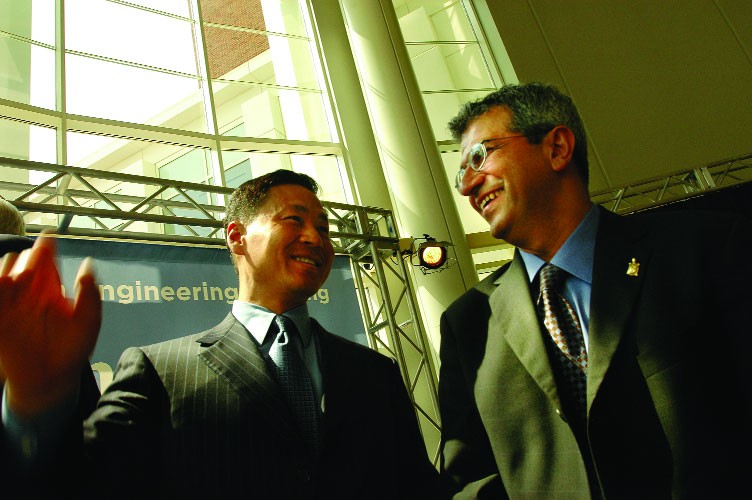Heavy hitters from the university, state government and technology industry gathered with a crowd of 500 on the campus yesterday to unveil a $56 million investment in the future of nanotechnology and bioengineering at the university.
The Jeong H. Kim Engineering building, under construction from December 2002 until January of his year, symbolizes the university’s role as a driving force in the state’s economy and should attract business to the state, said Gov. Robert Ehrlich at the opening ceremony. With more than a dozen labs, researchers will be at the forefront of nanotechnology and bio-engineering, university researchers said.
“The capabilities of this building will take us into the next era,” said Nariman Farvardin, dean of the A. James Clark School of Engineering. “It’s like a fireball in a fuel tank that will move us forward.”
Several types of engineering research will be housed under one roof, a rarity in the nation, officials said. Most research centers focus on one subject, but Kim’s researchers will share knowledge to tackle today’s research dilemmas.
The university has been ranked No. 1 in the nation for nanotechnology and now has the proper facility to maintain the position, said Jacques Gansler, university vice president of research.
“[The Kim Building] is beyond state-of-the-art,” said University System of Maryland Chancellor Brit Kirwan. “It defines the new state-of-the-art.”
Ehrlich and House Speaker Michael Busch sat on the stage and gave remarks at the late-morning dedication. The Kim Building is expected to attract research dollars that will be pumped back into the state economy through the technology sector, Ehrlich said.
“It’s another thing I can place on my list,” Ehrlich said. “It’s the little things that make the decision whether [tech companies] come to California or Maryland.”
Jeong H. Kim, for whom the building is named, received a standing ovation from guests for his contributions to the college. Kim, president of Bell Labs and an occasional university professor, said he is especially honored as a Korean native because no other campus building is named for an Asian-American.
“This building is a small tribute to this wonderful country,” Kim said.
Attendees, many of them leading figures in industry and government, were packed in the Kim Building’s lobby. Lines of audience members extended through three floors, as many watched from stairs and railings.
“I’m excited for the students that will have this learning space,” Kim said. “I’m excited about the new innovations.”
Monday’s guests were offered tours of the building, including the virtual reality lab, polymer research lab, lounges and the clean room.
Nanotechnology, a focal point of university and nationwide research, will find its home in the clean room.
Nanotech objects are 100 times thinner than a human hair, and applications include efficient solar cells and carbon semiconductors, said lab director Jim O’Connor.
The virtual reality lab is a typical room full of desks and computers, but it has an atypical feature in the back wall. Three giant display screens run from the floor to the ceiling. Researchers can walk into the screen area with goggles and gloves to become immersed in an environment, such as underwater during a torpedo shooting. Stresses and vibrations from subjects such as torpedoes will be measured by sensors and stored on computers.
The university will share the collected data with similar labs at Virginia Tech and Penn State universities, said Amr M. Baz, lab director and professor of mechanical engineering. Researchers will tweak specs to create the best engineering designs.
Overall, the Kim Building will allow university researchers to do more than your “bread and butter, normal engineering,” said university President Dan Mote.
“If you don’t have the right facility, you can’t work at the highest level,” Mote said. “This facility is unique and the best in the country – at least for the next year or so.”
Getting an innovative facility like the Kim Building is an opportunity that comes around once every few decades, Mote said.
Those sentiments were echoed Monday by George Dieter, a former dean of engineering at the university.
“This is a dream come true,” Dieter said. “This is really the first big lab facility the college has acquired since Glenn L. Martin Hall … It’s the first time we’ve gotten really world-class facilities.”
Contact reporter Tom Howell at howelldbk@gmail.com.





